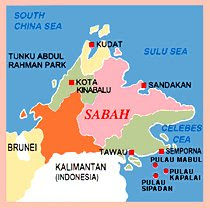
The western part of Sabah is generally mountainous, containing the three highest mountains in Malaysia. The most prominent range is the Crocker Range which houses several mountains of varying height from about 1,000 metres to 4,000 metres. At the height of 4,095 metres, Mount Kinabalu is the highest mountain in Malaysia and the second highest in Southeast Asia after Puncak Jaya in Indonesia. While the government of Malaysia officially considers it the highest mountain in Southeast Asia, there are counterclaims that Puncak Jaya is the highest mountain. The argument centres around whether New Guinea could be considered a part of Southeast Asia. So far there is no precise consensus on this, and the view that Mount Kinabalu is indeed the tallest mountain in Southeast Asia is more prevalent. The jungles of Sabah are classified as rainforests and host a diverse array of plant and animal species. Kinabalu National Park was inscribed as a World Heritage Site in 2000 because of its richness in plant diversity combined with its unique geological, topographical, and climatic conditions.[6]
Lying nearby Mount Kinabalu is Mount Tambuyukon. At a height of 2,579 metres, it is the third highest peak in the country. Adjacent to the Crocker Range is the Trus Madi Range which houses the second highest peak in the country, Mount Trus Madi, at a height of 2,642 metres. There are lower ranges of hills extending towards the western coasts, southern plains, and the interior or central part of Sabah. These mountains and hills are traversed by an extensive network of river valleys and are in most cases covered with dense rainforest.
The central and eastern portion of Sabah are generally lower mountain ranges and plains with occasional hills. Kinabatangan River begins from the western ranges and snakes its way through the central region towards the east coast out into the Sulu Sea. It is the second longest river in Malaysia after Rejang River at a length of 560 kilometres. The forests surrounding the river valley also contains an array of wildlife habitats, and is the largest forest-covered floodplain in Malaysia.[7]
 Other important wildlife regions in Sabah include Maliau Basin, Danum Valley, Tabin, and Sepilok. These places are either designated as national parks, wildlife reserves, virgin jungle reserves, or protection forest reserve.
Other important wildlife regions in Sabah include Maliau Basin, Danum Valley, Tabin, and Sepilok. These places are either designated as national parks, wildlife reserves, virgin jungle reserves, or protection forest reserve.Over three quarters of the human population inhabit the coastal plains. Major towns and urban centers have sprouted along the coasts of Sabah. The interior region remains sparsely populated with only villages, and the occasional small towns or townships.
Beyond the coasts of Sabah lies a number of islands and coral reefs, including the largest island in Malaysia, Pulau Banggi. Other larger islands include, Pulau Jambongan, Pulau Balambangan, Pulau Timbun Mata, Pulau Bumbun, and Pulau Sebatik. Other popular island mainly for tourism are, Pulau Sipadan, Pulau Selingan, Pulau Gaya, Pulau Tiga, Pulau Layang-Layang, and many more.




No comments:
Post a Comment